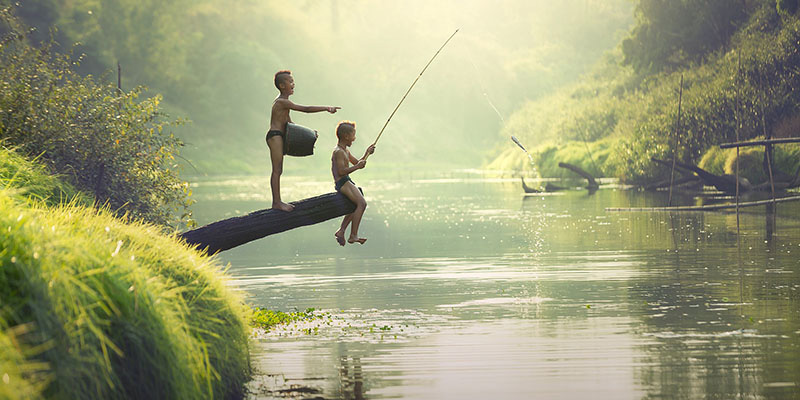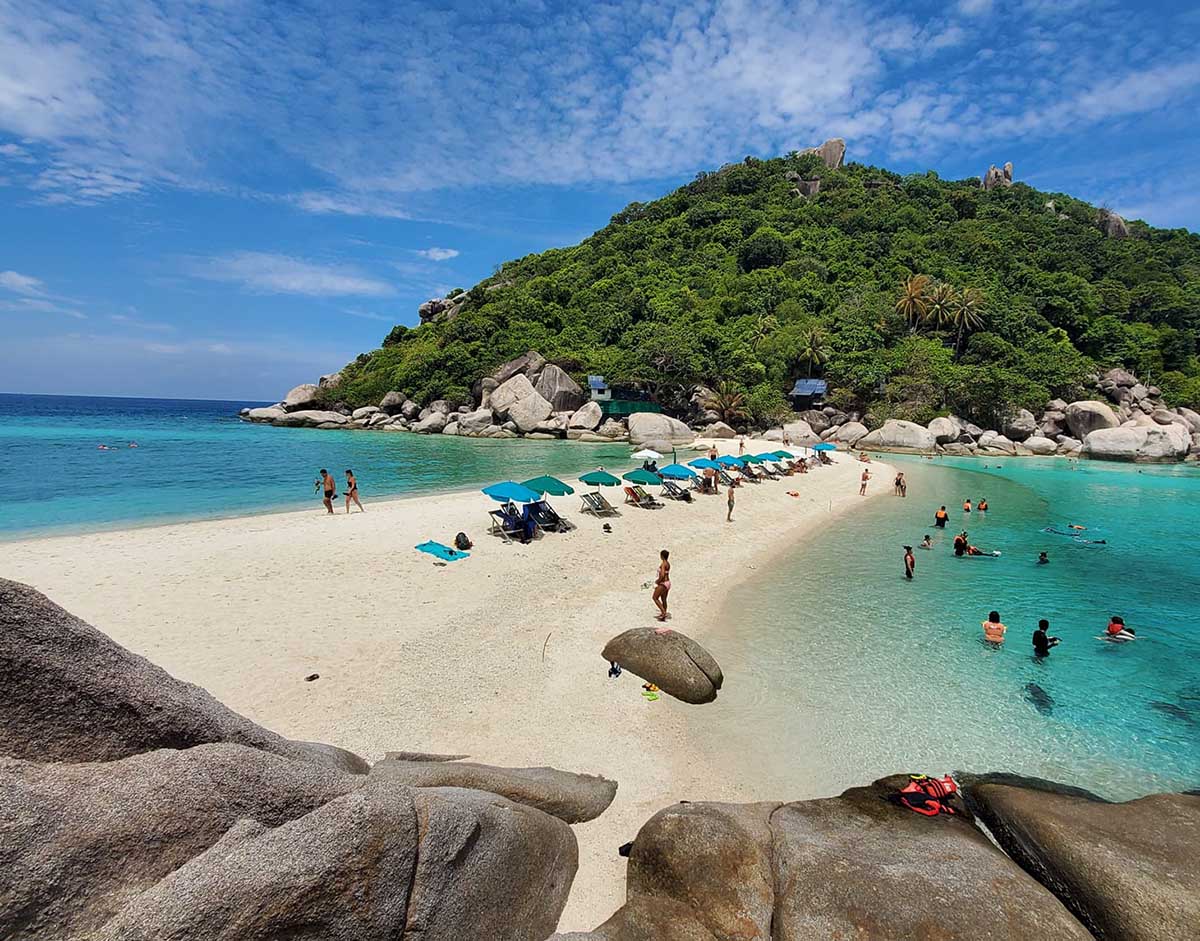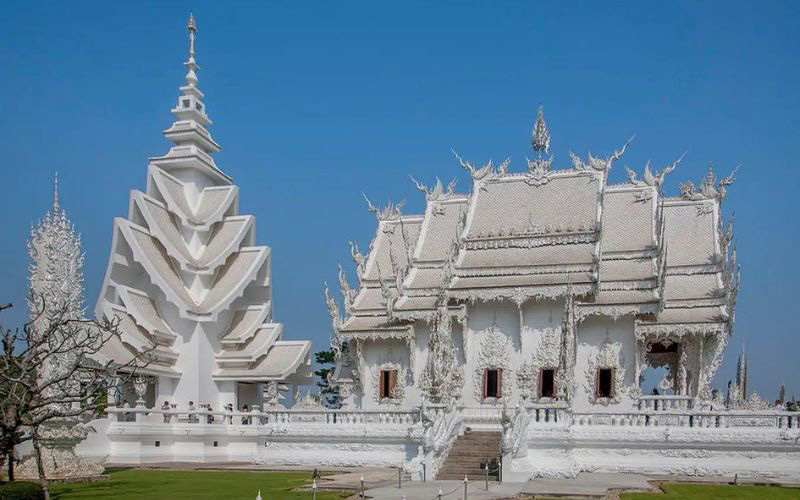Best Time to Visit Thailand for the Weather
Thailand is a diverse and beautiful country with a climate that varies significantly across its regions. When planning a trip to the Land of Smiles, it's essential to understand the weather patterns to ensure the most enjoyable experience. In this blog post, we'll explore the best time of year to visit Thailand based on the country's climate, focusing on the most pleasant weather conditions.

Best Time to Visit Thailand for the Weather
Thailand's Climate Zones
Thailand's climate can be divided into three primary zones: Northern and Central Thailand, Southern Thailand, and Northeastern Thailand (Isaan). Each zone experiences different weather patterns throughout the year, which can impact your travel plans.
Northern and Central Thailand
-
Cool season (November to February): Mild temperatures and minimal rainfall.
-
Hot season (March to May): Marked by high temperatures and occasional thunderstorms.
-
Rainy season (June to October): Features heavy rainfall and high humidity.
Southern Thailand
-
East Coast: Experiences less rainfall than the west coast, with the rainy season typically lasting from September to December.
-
West Coast: Has a more extended rainy season, usually lasting from April to October.
Northeastern Thailand (Isaan)
This region experiences a similar climate to Northern and Central Thailand, with a cool, hot, and rainy season.
Best Time for Pleasant Weather: Cool Season (November to February)
The cool season in Thailand, which lasts from November to February, is considered the best time to visit for pleasant weather. During this period, you can expect the following:
-
Comfortable temperatures: The cool season offers mild temperatures, making it perfect for exploring outdoor attractions and engaging in activities.
-
Minimal rainfall: Rainfall is at its lowest during the cool season, providing clear skies and sunny days.
-
Ideal conditions for outdoor activities: The pleasant weather makes this the perfect time for sightseeing, hiking, and beach activities.
Popular destinations and activities during the cool season include exploring Bangkok's temples, visiting Chiang Mai's night markets, and sunbathing on Phuket's beaches.
Shoulder Season: A Compromise (March and October)
If you're seeking a balance between pleasant weather and fewer tourists, consider visiting Thailand during the shoulder season in March and October. This period offers:
-
Moderate temperatures: Although slightly warmer than the cool season, temperatures remain relatively comfortable during the shoulder season.
-
Less rainfall compared to the rainy season: While occasional showers may occur, the overall rainfall is lower than during the rainy season.
-
Fewer tourists than the high season: The shoulder season sees fewer visitors than the peak months, allowing for a more relaxed trip.
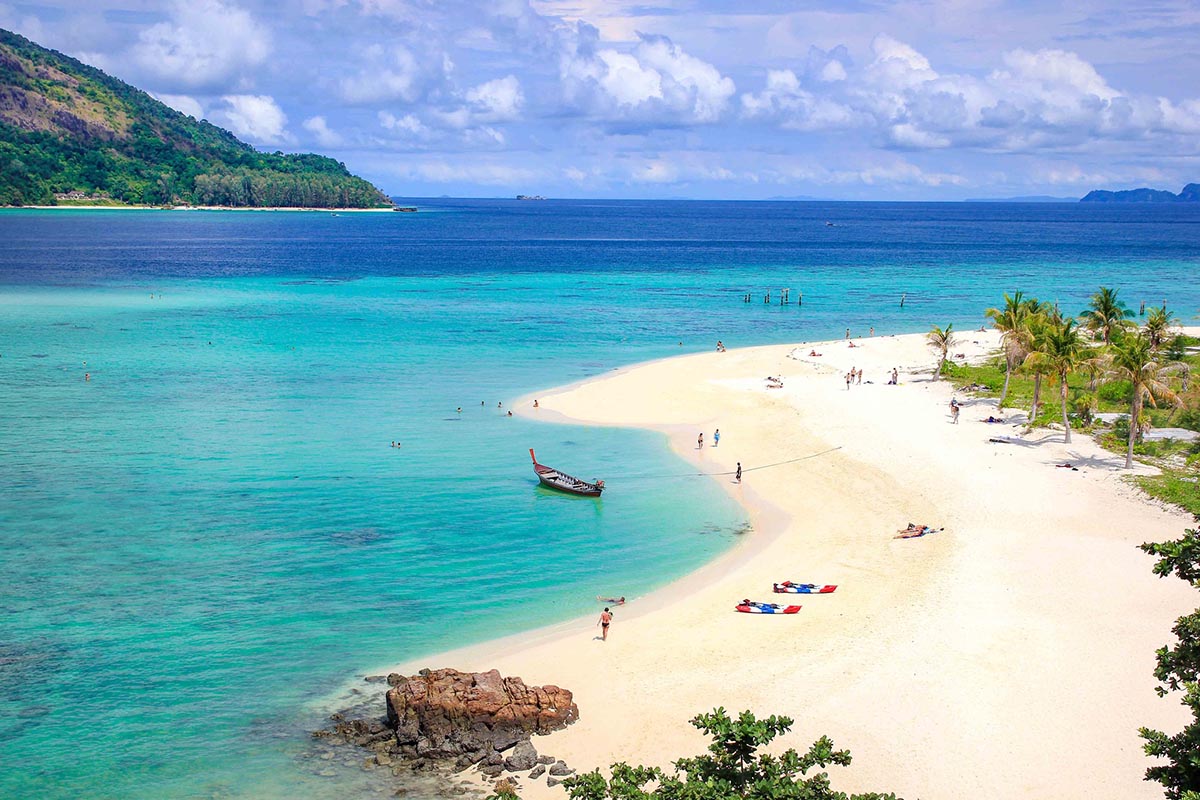
Thailand's sunny emerald beaches
Weather Considerations by Region
When planning your trip to Thailand, it's essential to consider the specific weather patterns of each region:
Northern Thailand
-
Chiang Mai: The cool season is ideal for exploring the city and surrounding countryside, while the rainy season brings lush landscapes and fewer tourists.
-
Chiang Rai: Like Chiang Mai, the cool season provides the best weather for sightseeing and outdoor activities.
Central Thailand
-
Bangkok: The cool season offers the most comfortable temperatures for exploring the bustling city, while the rainy season can bring heavy downpours and flooding.
-
Ayutthaya: As with Bangkok, the cool season is optimal for visiting this historic city, while the rainy season may disrupt outdoor activities.
Southern Thailand
-
Phuket and Krabi (West Coast): The best time to visit these beach destinations is during the cool season when the weather is sunny and dry.
-
Koh Samui and Koh Tao (East Coast): These islands are best visited during the cool or shoulder months, as the rainy season is typically shorter and less intense than on the west coast.
Northeastern Thailand (Isaan)
The cool season is the best time to visit this off-the-beaten-path region, as temperatures are mild and rainfall is minimal.
Tips for Planning Your Trip Based on Weather Preferences
When planning your trip to Thailand, consider the following tips:
-
Research regional climates: Investigate the specific weather patterns of the destinations you plan to visit.
-
Consider the timing of local festivals and events: Some events, like the Yi Peng Lantern Festival in Chiang Mai, occur during specific months and may influence travel dates.
-
Pack appropriately for the weather: Bring clothing and gear suitable for the climate during your visit.
-
Be flexible with travel plans: Be prepared to adapt your itinerary if the weather becomes unpredictable.
The best time to visit Thailand for pleasant weather is during the cool season (November to February), with the shoulder season (March and October) offering a good compromise between comfortable temperatures and fewer tourists.
Best Time to Visit Thailand for Various Attractions
Thailand, known as the Land of Smiles, is a popular travel destination offering diverse attractions. This guide will help you determine the best time to visit Thailand based on your interests: beach hopping, sightseeing, adventure, religious exploration, or shopping.
1. Beach and Islands Attractions
Thailand is famous for its picturesque beaches and stunning islands. Some top beach destinations include Phuket, Krabi, Koh Samui, and Koh Phi Phi.

Phuket beach in Thailand
-
Best time to visit Thailand beaches: The ideal time to enjoy these beautiful beaches is from November to April, during Thailand's dry season. The weather is sunny and perfect for swimming, snorkeling, and sunbathing.
-
Tips: Remember to pack sunscreen, a hat, and sunglasses, as the sun can be intense during this period. Also, avoid visiting during the peak tourist season (December-January) if you prefer less crowded beaches.
2. Sightseeing Attractions
Thailand is home to numerous historical and cultural landmarks. Bangkok, Chiang Mai, and Ayutthaya are some of the top cities for sightseeing.
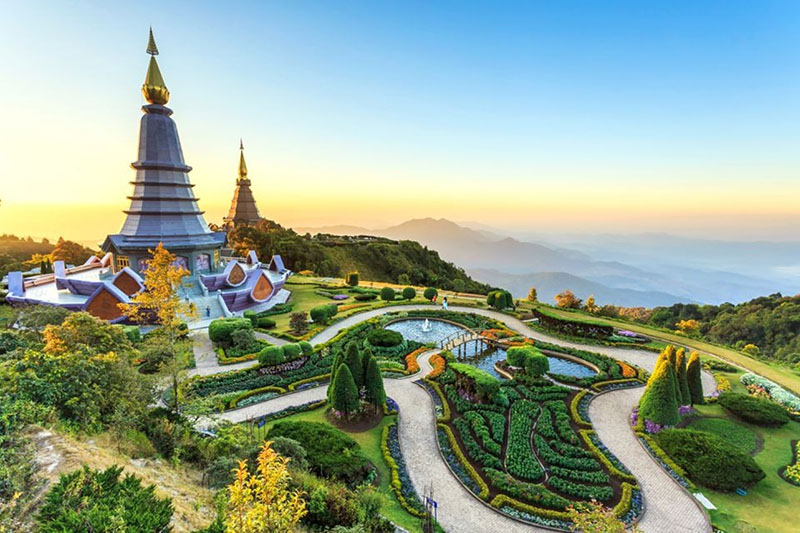
Chiang Mai in Thailand
-
Best time to visit: Sightseeing in Thailand is enjoyable year-round, but the cooler months from November to February offer more comfortable temperatures for exploring outdoor attractions.
-
Tips: When visiting temples or other religious sites, dress modestly by covering your shoulders and knees. It's also a good idea to carry a reusable water bottle to stay hydrated during sightseeing.
3. Adventure Attractions
If you're seeking adventure, Thailand offers plenty, from jungle trekking in Chiang Mai to rock climbing in Krabi.

Rock climbing in Krabi, Thailand
-
Best time to visit: The best time for adventure activities is during the dry season, from November to April. The weather is more predictable during this time, and the risk of rain-related disruptions is lower.
-
Tips: Book your adventure activities through a reputable tour operator and ensure they follow safety guidelines. Invest in good quality gear and travel insurance to protect yourself during your adventures.
4. Religious Attractions
Thailand is a predominantly Buddhist country with numerous temples, pagodas, and spiritual sites. Some famous religious attractions include Wat Phra Kaew in Bangkok, Wat Rong Khun in Chiang Rai, and Doi Suthep in Chiang Mai.
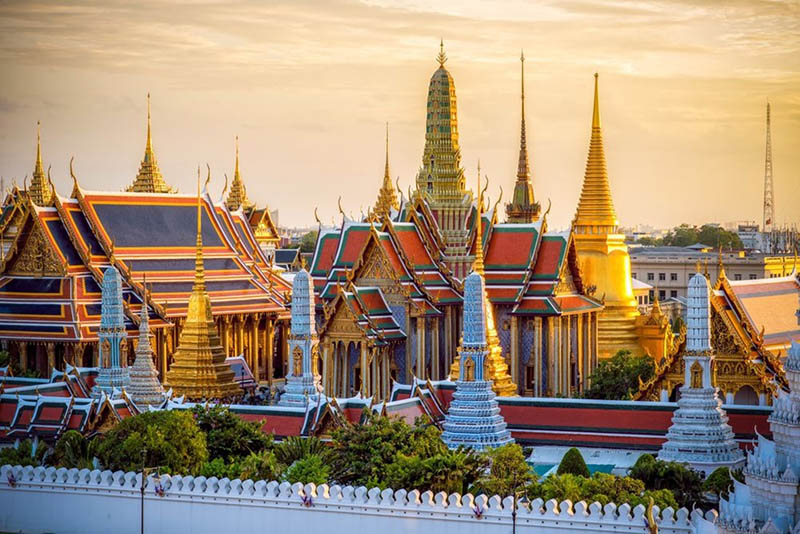
Wat Phra temple in Bangkok, Thailand
-
Best time to visit: As with sightseeing, visiting religious attractions can be done year-round, but the cooler months from November to February are more comfortable for exploring outdoor sites.
-
Tips: Be respectful when visiting religious sites by dressing modestly, removing your shoes before entering temples, and avoiding loud noises or disruptive behavior.
5. Shopping
Thailand is a shopper's paradise, offering everything from bustling markets to high-end malls. Bangkok, Chiang Mai, and Pattaya are popular shopping destinations.
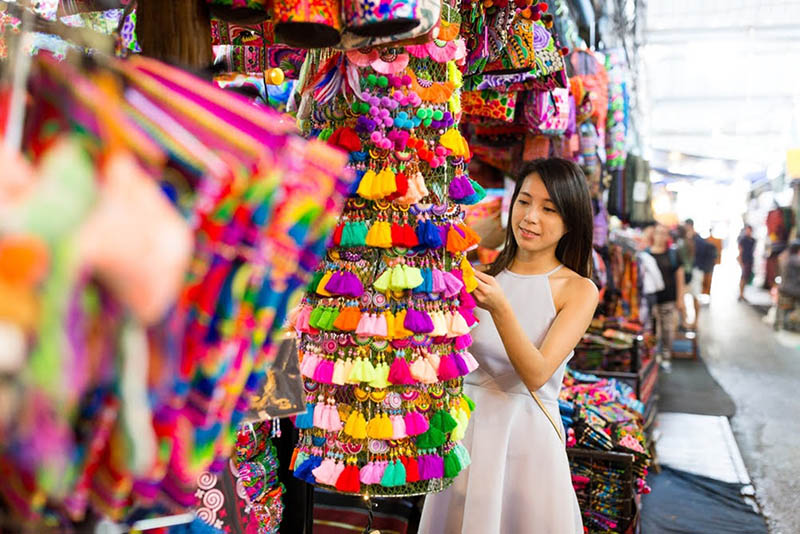
Shopping at local Thai markets
-
Best time to visit: Shopping can be enjoyed throughout the year. However, the rainy season (May to October) offers a unique experience, as you can explore the vibrant indoor markets and shopping centers while escaping the rain.
-
Tips: Be prepared to haggle when shopping at local markets, and always carry cash, as many vendors do not accept credit cards. Additionally, it's a good idea to bring a reusable shopping bag to reduce plastic waste.
While the dry season (November to April) is generally more favorable for beach activities and outdoor adventures, the cooler months (November to February) are perfect for sightseeing and exploring religious attractions.
Best Time to Visit Thailand for Low Prices
Thailand, a popular travel destination known for its stunning beaches, rich culture, and mouthwatering cuisine, attracts millions of tourists yearly. Below we'll explore the best time of year to visit Thailand if you want to save money while enjoying an unforgettable trip.
Low Season vs. High Season
When planning your vacation, it's important to understand the difference between Thailand's low and high seasons. The low, rainy, or green season typically sees fewer tourists and lower prices on accommodations and flights. In contrast, the high season brings an influx of tourists and higher prices due to increased demand, which is not the cheapest time to go to Thailand.

Best Time to Visit Thailand for Low Prices
Best Time for Low Prices: Rainy Season (May to October)
The rainy season in Thailand, which lasts from May to October, is considered the cheapest month to visit Thailand for low prices. During this period, you can expect to find the following:
-
Lower accommodation rates: Hotels and guesthouses often offer discounted prices during the rainy season, allowing you to stay at luxurious properties without breaking the bank.
-
Cheaper flights: Airfare to Thailand is generally more affordable during the rainy season, as airlines lower their prices to attract travelers.
-
Less crowded attractions: With fewer tourists visiting during this time, you can explore famous attractions without the crowds.
However, there are some potential drawbacks to traveling during the rainy season:
-
Unpredictable weather: While the rain usually comes in short bursts, it can occasionally disrupt outdoor activities and plans.
-
Limited outdoor activities: Some outdoor excursions, such as island hopping or trekking, may be challenging or unavailable due to the weather.
-
Some islands and attractions may be closed: In certain areas, especially on the Andaman coast, some islands and attractions may be closed or inaccessible due to rough seas.
Shoulder Season: A Compromise (April and November)
If you're seeking a balance between affordability and favorable weather, consider visiting Thailand during the shoulder season in April and November. This period offers:
-
Moderate prices: Accommodation rates and airfares are generally lower than during the high season but slightly higher than during the rainy season.
-
Good weather conditions: The shoulder season transitions between the hot and rainy seasons, offering generally pleasant weather for exploring.
-
Fewer tourists than the high season: While not as quiet as the rainy season, the shoulder season still sees fewer visitors than the peak months, allowing for a more relaxed trip.
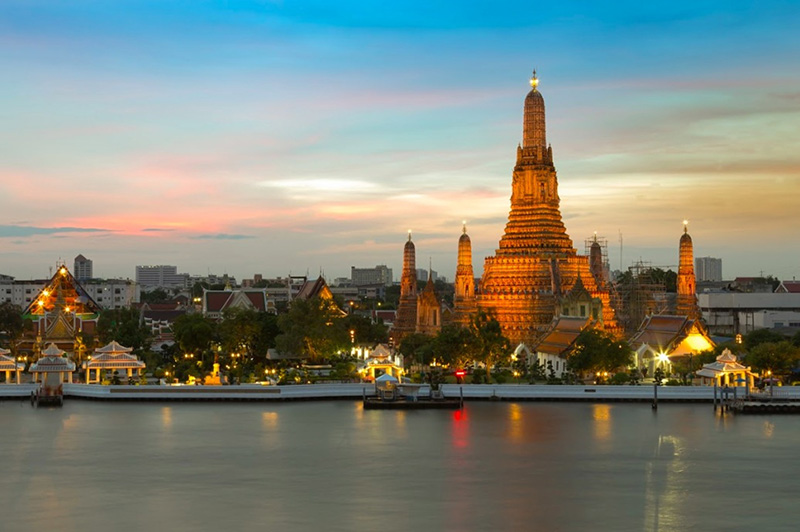
Thailand’s religious tourist attractions
Tips for Saving Money While Traveling in Thailand
Regardless of when you choose to visit, here are some tips to help you save money during your trip to Thailand:
-
Booking accommodations in advance: Research and book your accommodations early to secure the best deals.
-
Research affordable dining options: Look for local eateries and street food vendors, often serving delicious meals at low prices.
-
Utilizing public transportation: Save money using public transportation options like buses, trains, and tuk-tuks instead of taxis or private cars.
-
Exploring free or low-cost attractions: Opt for free or low-cost activities, such as visiting temples, parks, and markets, to stretch your budget further.
-
Traveling with a group to share expenses: If possible, travel with friends or family members to share the costs of accommodations, transportation, and activities.
The best time to visit Thailand for low prices is during the rainy season (May to October), with the shoulder season (April and November) offering a good compromise between affordability and favorable weather. By planning your trip during these periods and following our money-saving tips, you can enjoy a memorable and budget-friendly vacation in the Land of Smiles.
Best Time to Visit Thailand for Festivals
Thailand is a country known for its rich cultural heritage and vibrant festivals. These events showcase the nation's traditions, beliefs, and customs, making them essential to any traveler's journey through the Land of Smiles. Let's explore the best month to visit Thailand based on its diverse array of festivals, ensuring that your trip is filled with unforgettable memories and experiences.
Major Thai Festivals by Month
Thailand's festival calendar is packed with exciting events throughout the year, so no matter when you plan to visit, there's likely to be a celebration taking place. Here's a breakdown of some of the major Thai festivals by month:
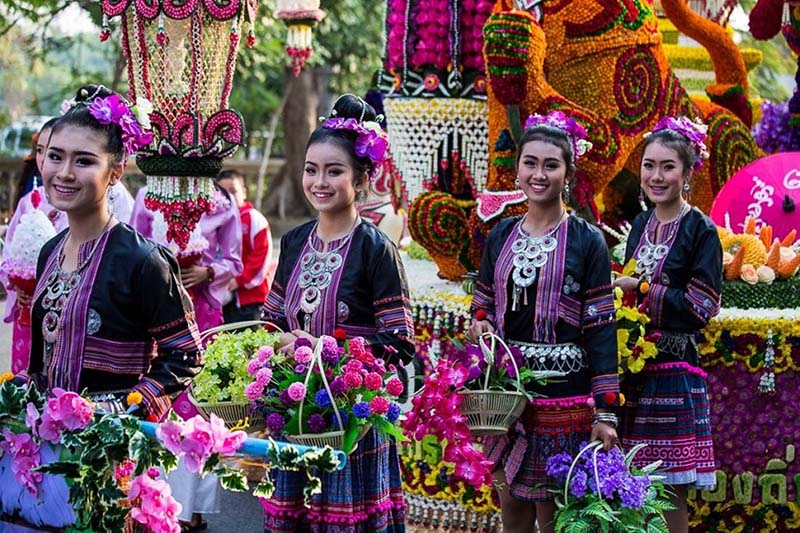
Chiang Mai Flower Festival
January
-
Bo Sang Umbrella Festival: Held in Chiang Mai, this colorful event celebrates the art of handmade paper umbrellas and features parades, cultural performances, and craft demonstrations.
-
Chiang Mai Winter Fair: A lively annual fair featuring food stalls, concerts, and carnival rides, perfect for experiencing local culture and entertainment.
February
-
Chiang Mai Flower Festival: This event showcases Chiang Mai's beautiful flowers in full bloom, with parades, floral displays, and gardening competitions.
-
Makha Bucha Day: A nationwide Buddhist holiday marked by temple visits, candlelit processions, and merit-making activities.
March
-
Pattaya International Music Festival: A free multi-day music festival featuring local and international artists held along Pattaya Beach.
-
National Elephant Day: A day dedicated to raising awareness and promoting the conservation of Thailand's national animal, with special events held nationwide at elephant sanctuaries and parks.

A unique experience at Songkran Festival (Thai New Year)
April
-
Songkran Festival (Thai New Year): The most famous Thai festival, Songkran, is marked by water fights, street parties, and traditional ceremonies throughout the country.
-
Chakri Day: A national holiday commemorating the founding of the Chakri Dynasty, with ceremonies held at the Grand Palace in Bangkok.
May
-
Visakha Bucha Day: One of the holiest days in Buddhism, this event commemorates the birth, enlightenment, and passing of the Buddha with temple visits, candlelit processions, and merit-making activities.
-
Royal Ploughing Ceremony: An ancient royal ritual in Bangkok to mark the beginning of the rice planting season, featuring colorful processions and sacred ceremonies.
-
Samui Regatta: An annual sailing competition in the Gulf of Thailand attracts sailors worldwide.
June
-
Phi Ta Khon: Also known as the Ghost Festival, this unique event in Loei province sees locals donning elaborate ghost masks and participating in lively parades and dances.
-
Sunthorn Phu Day: A celebration of Thailand's most famous poet, featuring poetry recitals, cultural performances, and exhibitions.
-
Bangkok International Film Festival: A summer film festival featuring screenings of international and Thai films.
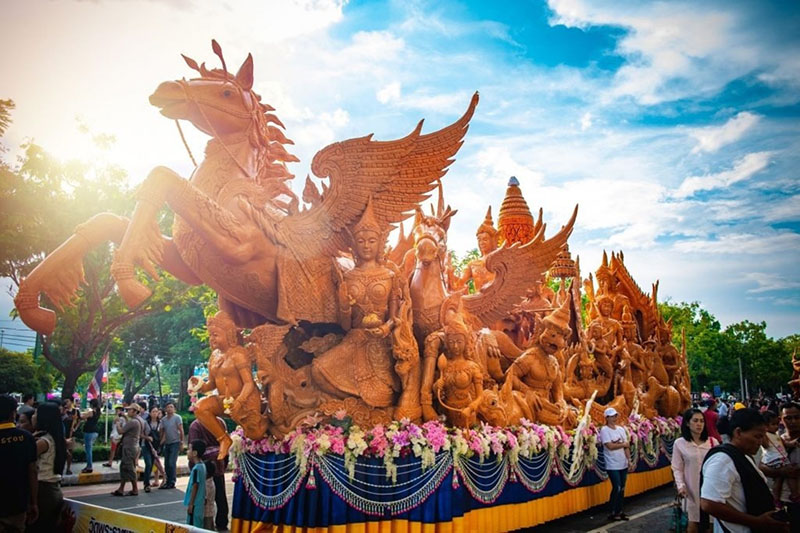
Candle Festival in Thailand
July
-
Asahna Bucha Day is another important Buddhist holiday that begins the Buddhist Lent with temple visits and religious ceremonies.
-
Candle Festival: Held in Ubon Ratchathani, this event features elaborate wax sculptures and candlelit processions to mark the beginning of the Buddhist Lent.
August
-
Queen Sirikit's Birthday (Mother's Day): A national holiday honoring the queen's birthday, with celebrations, fireworks, and special events held nationwide.
-
Por Tor Hungry Ghost Festival: Celebrated by the Chinese-Thai community, this event features food offerings and elaborate paper effigies to appease the spirits of deceased ancestors.
September
-
Sat Duan Sip (Ancestor Worship Festival): A Chinese-Thai festival where families gather to pay respects to their ancestors with food, flowers, and incense offerings.
-
Salak Yom Festival: Held in Lamphun, this event features the construction of towering bamboo structures adorned with colorful paper offerings to honor deceased ancestors.
October
-
Vegetarian Festival: A nine-day event observed by the Chinese-Thai community, featuring ritualistic ceremonies, processions, and the consumption of strictly vegetarian meals.
-
Naga Fireball Festival: A mysterious natural phenomenon where glowing orbs of light rise from the Mekong River, accompanied by local celebrations and festivities.

Loy Krathong Festival
November
-
Loy Krathong Festival: One of Thailand's most picturesque events, where locals release decorated floating baskets (krathongs) into rivers and waterways to respect the water spirits.
-
Yi Peng Lantern Festival: Celebrated in Chiang Mai, this beautiful event sees thousands of lanterns released into the night sky, creating a magical atmosphere.
December
-
King Bhumibol's Birthday (Father's Day): A national holiday commemorating the late king's birthday, with special events, fireworks, and celebrations throughout the country.
-
New Year's Eve: Thais welcome the New Year with parties, fireworks, and festivities in cities and towns nationwide.
Tips for Attending Festivals in Thailand
When planning your trip around Thai festivals, consider the following tips:
-
Research specific festival dates and locations: Dates can vary yearly, so ensure you have the most accurate information when planning your trip.
-
Book accommodations and transportation in advance: Popular festivals can result in fully booked hotels and transportation, so reserve your arrangements early to avoid disappointment.
-
Dress appropriately for religious or cultural events: Respect local customs by modestly and adhering to dress codes, especially at temples and religious ceremonies.
-
Be respectful of local customs and traditions: When attending festivals, be mindful of local etiquette and always respect each event's cultural significance.
-
Participate in festival activities to fully immerse yourself in the experience: Join in on the celebrations, try traditional foods, and engage with locals to make the most of your festival experience.
The best time to visit Thailand for festivals depends on your interests and the specific events you'd like to attend. With a wide range of celebrations throughout the year, there's something for everyone to enjoy. By incorporating Thai festivals into your travel itinerary, you'll gain a deeper understanding of the country's rich culture and create lasting memories of your journey.
Recommended Itinerary for Every Season in Thailand
Thailand is a captivating country with a diverse landscape, rich culture, and abundant attractions. With its tropical climate and distinct seasons, picking the right time for your visit is essential. This guide provides a recommended itinerary for every season in Thailand, ensuring that you make the most of your trip, regardless of when you choose.
The Cool Season (November to February)
The cool season in Thailand is characterized by mild temperatures and low humidity, making it the perfect time to explore the bustling city of Bangkok and the beautiful northern regions like Chiang Mai. Outdoor activities such as trekking and cycling are ideal during this time, and you'll also have the opportunity to attend famous festivals like Loi Krathong and the Chiang Mai Flower Festival.
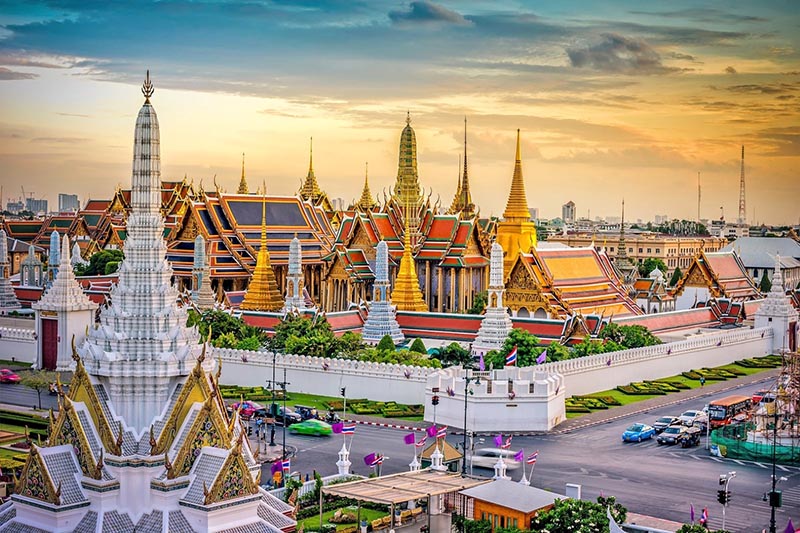
Thailand’s Grand Palace
Day-by-day itinerary for the Cool Season:
-
Arrival in Bangkok: Begin your Thai adventure in the vibrant city of Bangkok.
-
Explore Bangkok: Visit iconic sites like the Grand Palace, Wat Pho, and the lively Chatuchak Weekend Market.
-
Day trip to Ayutthaya: Discover the ancient ruins of the former Thai capital, just a short journey from Bangkok.
-
Travel to Chiang Mai: Head north to the cultural hub of Chiang Mai, known for its stunning temples and lush mountains.
-
Explore Chiang Mai: Visit the sacred Doi Suthep temple, explore Old City Temples, and shop at the Night Bazaar.
-
Day trip to Doi Inthanon National Park: Experience the breathtaking beauty of Thailand's highest peak and surrounding nature.
-
Departure: Bid farewell to Thailand and take home unforgettable memories.
The Hot Season (March to May)
The hot season in Thailand can be intense, with sweltering temperatures and high humidity. However, it's the perfect time to relax on the stunning beaches of Phuket or Koh Samui and explore the crystal-clear waters of the Andaman Sea. The famous Songkran Festival also takes place this season, offering a unique cultural experience.

Stunning Koh Phi Phi Islands
Day-by-day itinerary for the Hot Season:
-
Arrival in Phuket or Koh Samui: Start your trip on one of Thailand's beautiful islands, known for its idyllic beaches and vibrant nightlife.
-
Beach day and relaxation: Soak up the sun and unwind on the pristine sands of your chosen island.
-
Island hopping and snorkeling/scuba diving trip: Explore the underwater wonders of the Andaman Sea with a day spent snorkeling or scuba diving.
-
Explore local attractions: Discover the history and culture of Phuket Town or visit the charming Fisherman's Village in Koh Samui.
-
Attend Songkran Festival (if applicable): Join in the celebrations of Thailand's famous water festival, marking the beginning of the Thai New Year.
-
Day trip to nearby islands: Visit the stunning Phi Phi Islands or the picturesque Ang Thong National Marine Park.
-
Departure: Say goodbye to the tropical paradise and return home with lasting memories.
The Rainy Season (June to October)
While the rainy season in Thailand brings frequent showers, it also offers lush, green landscapes and fewer crowds. This is an excellent time to explore national parks like Khao Yai and Erawan or delve into the country's history in Kanchanaburi. Bangkok's indoor attractions also provide respite from the rain.
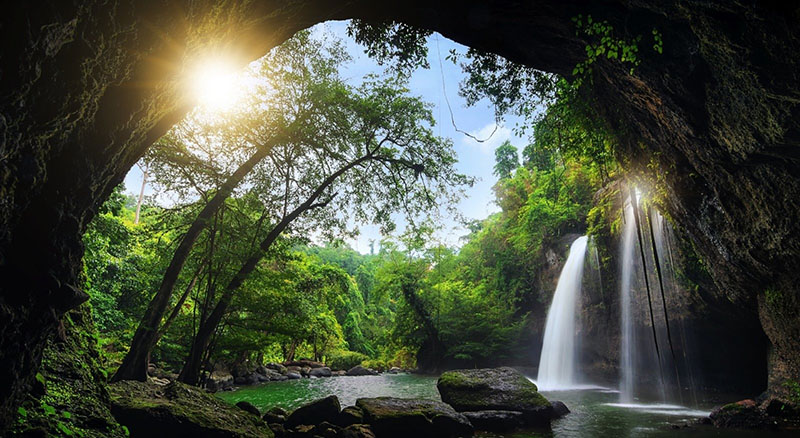
Khao Yai National Park
Day-by-day itinerary for the Rainy Season:
-
Arrival in Bangkok: Begin your journey in the bustling capital city.
-
Explore Bangkok: Visit the fascinating Jim Thompson House, shop at Siam Paragon, and explore the themed floors of Terminal 21.
-
Day trip to Kanchanaburi: Learn about Thailand's history with a visit to the Bridge over the River Kwai and the Death Railway.
-
Travel to Khao Yai National Park: Immerse yourself in the beauty of one of Thailand's oldest and most famous national parks.
-
Explore Khao Yai: Enjoy hiking, marvel at waterfalls, and spot wildlife in their natural habitat.
-
Return to Bangkok: Head to the capital for last-minute shopping or sightseeing.
-
Departure: Depart from Thailand with a newfound appreciation for its diverse offerings.
Thailand offers many experiences to suit every traveler, regardless of the season. Use these itineraries as a starting point to plan your perfect Thai adventure, and be prepared to create memories that will last a lifetime.

Thailand’s Krabi Islands
FAQs
Q: What should I pack when traveling to Thailand?
A: It is essential to pack the right items for your trip. Ensure you bring comfortable clothes and shoes for walking around, sunglasses and sunscreen to protect from the sun, a hat or cap, insect repellent, and any electronics you may need. You should also bring local currency (Thai baht) and enough cash to cover your expenses. Furthermore, ensure you have a valid passport for immigration purposes. With the right items packed, you can be sure your Thailand trip will be memorable!
Q: What are the must-see attractions in Thailand?
A: For most travelers, a trip to Thailand wouldn’t be complete without seeing some of its most famous attractions. From the bustling city of Bangkok to the idyllic beaches of Phuket and Koh Samui, there is something for everyone in Thailand. There are also many historical sites to explore, such as the ancient ruins of Ayutthaya and Sukhothai. Additionally, don’t forget to visit the famous temples of Chiang Mai and Wat Phra Kaew in Bangkok. With so many attractions, Thailand is an excellent destination for all travelers!
Q: What is the best way to get around in Thailand?
A: There are various ways to get around in Thailand. The most popular method of transport would be by bus, which can take you from one city to another. Alternatively, you can rent a car or motorbike for more freedom in your travels. Trains and domestic flights are also available for those who want to cover more ground. Finally, for a unique experience, you can opt for tuk-tuks and water taxis in certain areas. With so many transport options, getting around Thailand is easy and convenient!
Q: What should I be aware of when traveling in Thailand?
A: Knowing the local customs and etiquette is important when traveling in Thailand. It is also advised that you dress modestly and respect religious sites. Additionally, ensure you always have some form of identification with you. Lastly, be careful of the heat and sun exposure as Thailand’s climate can get very hot during certain times of the year.
Q: What should I remember when planning to travel to Thailand?
A: When planning your vacation to Thailand, it’s important to consider the weather and regional festivals that might affect the availability of attractions or transportation. Additionally, be sure to research safety tips from tourism experts before you go, such as not carrying valuables with you and avoiding certain areas where crime might be an issue. Finally, always carry a copy of your passport with you for identification purposes.
When’s the best time to go to Thailand? No matter when you plan your trip, it’s important to research the best time to visit Thailand for your specific needs. The Hot Season (November to May) is the best time to travel to Thailand for tourists due to its warm weather and clear waters in the Andaman Sea. On the other hand, the Rainy Season (June to October) brings fewer crowds and offers the chance to explore natural attractions and national parks. Once you’ve chosen your ideal time to visit, create an itinerary that suits your interests and plan a memorable trip. With the proper preparation, you’ll be sure to make the most of your time in this tropical paradise. New Asia Tours can help you plan the perfect Thailand and Vietnam package tour. Contact us to start creating your dream trip today!


